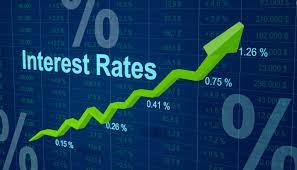The idea that these stocks are not sensitive to higher interest rates, while these over here are, is true. But that does depend more than a little bit on the weight we put on that word “sensitive”. For at some level of movement of interest rates all stocks will change in price. Other levels of interest rate change will benefit some shares, lower the prices of others. Further, if we use sensitive to mean relative price changes then we can say that certain sectors are not sensitive to higher rates in the same way that others are.

That all sounds a little complicated so it’s worth explaining what is meant by a share price being sensitive to higher interest rates. We can look at either the microeconomy – the effects on a specific share and it’s specific position – or the macroeconomic. The macroeconomic is easiest dealt with. Investors – to distinguish from traders – buy shares for the future income that comes from them. If interest rates rise, go higher, the that future stream from the entire sector of shares is worth less. Because we can now gain a higher income from bank accounts, bonds, loans and so on. So, the extra risk of share price movements – and also the higher income from dividends – is worth less. Rising interest rates should lower the value of stocks when compared to loans that is.
Banks and rising interest rates
But we can go deeper, into the microeconomics. For example, banks benefit from rising interest rates. We can see this in Lloyds (LON: LLOY) results: “ Underlying net interest income up 15 per cent, significantly driven by a stronger banking net interest margin of 2.84 per cent year to date (2.98 per cent in the third quarter)”. Rising interest rates increase the gap between deposit and lending rates – bank profits go up. As that same profits release shows though, really higher interest rates increase the chance of recession and loan losses, which then damage profits. This is true for all banks in this scenario, Barclays (LON: BARC), NatWest (LON: NWG) and so on.

Electric vehicles and interest rate sensitivity
On the other hand companies that are eating capital currently – say, Rivian (NASDAQ: RIVN) – find that their future possible profits are worth less than they used to be. Because we can earn interest on our money right now, instead of having to wait for that profitable future. This also means that Tesla (NASDAQ: TSLA) is worth more relative to Rivian because they’re both in the same market but one is making profits now, the other is still eating that capital.

We can take that specific principle and apply it across the entire market as well. Rising interest rates make those making profits now, paying dividends now, worth more than those investing still for some glorious future. Unilever (LON: ULVR) has been paying dividends for decades, makes profits now. It’s also to some extent protected from inflation because it’s in fast moving consumer goods. A rise in the price of FMCG is pretty much what inflation is – so, if there’s inflation then FMCGs are going up in price. Those who sell FMCG, like Unilever, are somewhat protected from the price changes that are inflation. This is also likely to true of utilities – like Severn Trent (LON: SVT).
Interest rates and industrial sectors
The issue here is, the point to be made, that while all stocks and shares are in some sense sensitive to higher interest rates that sensitivity affects share prices in different ways. Some find their relative value falling as rates rise (Rivian, say) while others should see that relative value rise (Tesla, in our example). That’s because of the maturity of the business itself, profitable or not as yet. Then there’re those sectoral differences, banks benefit from wider interest margins, until recession increases loan losses, utilities and FMCG generally are priced protected against inflation and so handle rising interest rates better.
Real and nominal interest rates
There is one further point we’ve got to make here. Yes, we are indeed seeing rising interest rates at present. But those are rising nominal interest rates – interest rates before inflation. Now that CPI inflation is at 9.6% we have seen, in the past few months, a fall in real interest rates. No, really, 9.6% minus 3% base rate is a lower interest rate than 1% base rate and 2% inflation when measured in those real terms, after adjusting for inflation. Nominal interest rates are a problem for cash flow, real interest rates are what matter for the value of money after that problem. The two are not the same thing at all.